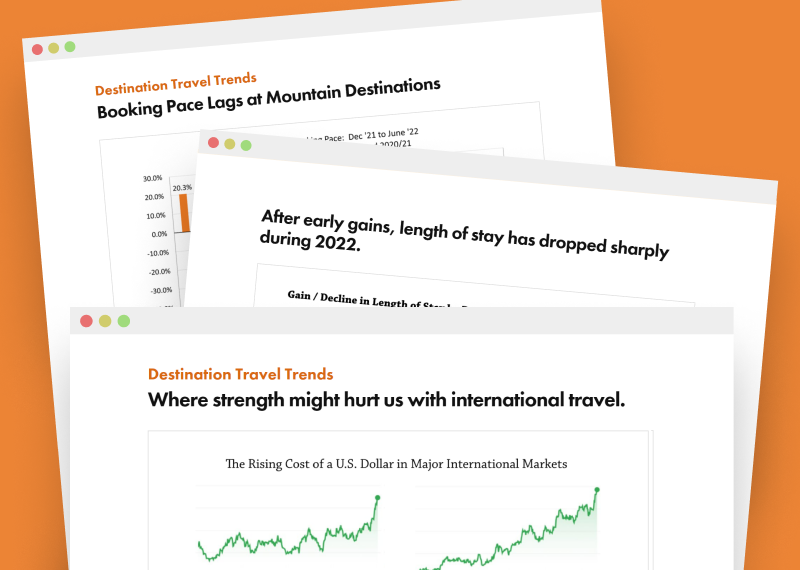

 Katie Barnes
Katie Barnes
After a late summer and fall impacted by destructive hurricanes, vacation destinations throughout the Southeast recovered during December with healthy increases in both occupancy and revenues despite a booking pace that dropped during the month for the remainder of the winter season. As of Dec. 31, actual occupancy during December among participating destinations was up a sharp 8.4 percent compared to December 2016 while the Average Daily Rate (ADR) dipped an aggregated 3.7 percent. The boost in occupancy helped overcome the slip in rates and led to an aggregated 4.4 percent increase in revenues for the month compared to last December.
The most updated data was released by Inntopia in their monthly DestiMetrics Market Briefing, distributed to participating destination marketing organizations and lodging properties in seven southeastern destinations.
The picture for the full winter also reveals some evidence of recovering patterns. For the six months from November through April, aggregated occupancy as of Dec. 31 is up 7.9 percent compared to last winter with increases being posted in five of the six winter months led by January and February. April is the only month currently showing an occupancy decline. As daily rates slipped last fall, visitors responded with increased bookings for the winter, leading to a 7.1 percent increase in revenue for the winter months as of Dec. 31 compared to the same time last year.
“There is no question that these upticks in winter occupancy were driven by last fall’s attractive lower rates. Revenues are continue to be up year-over-year as the increased occupancy figures significantly offset the lower ADRs that were offered following the hurricane season,” explained Tom Foley, vice president of Business Intelligence for Inntopia and author of the Briefing. “For the past 30 days, we’ve been watching pricing strategies evolve in response to normalizing market forces. As destination visitors increasingly booked at the more attractive post-hurricane rates, occupancy has filled in and rates are creeping up in a more typical pattern due to increasing demand.”
The Market Briefing also includes a concise review and analysis of key economic indicators that may influence destination travel. The Dow Jones Industrial Average continued its unprecedented rise in December by gaining another 1.8 percent, posting the eighth consecutive all-time monthly record. The Dow once again posted its highest single day closing in market history as Wall Street reacted enthusiastically to the passage of tax reform legislation. In contrast, the Consumer Confidence Index experienced a significant 5.8 percent decrease during the month, but still remains at one of its highest levels in the past 17 years at 122.1 points. The 148,000 new jobs added in December were below analysts’ expectations, but still strong enough to buoy up the markets and continue the 87-month streak of positive job growth that began in October 2010. The Unemployment Rate remained unchanged at 4.1 percent for the third consecutive month.
Despite the many positive indicators for destination tourism, Foley also added some cautionary notes. Bookings made in December for arrivals in the months from December through May are down a striking 32.6 percent compared to bookings made in December of 2016 for the remainder of the winter. December bookings were down for the remaining winter months ranging from a 24.8 percent skid in January to a 62.1 percent downward plunge for April arrivals.
“While the overall season is looking good at this point because attractive room rates encouraged early long-lead bookings, occupancy and revenue gains are not as dramatic as they were even a month ago,” noted Foley. “Lodging properties have spent the past three months working to re-establish rates after dropping them sharply in the wake of regional storms last summer, which is slowing the overall pace but at the same time, marking a return to more standardized pattern of usage,” he clarified.
“The upshot is that a strong foundation of bookings was established strategically and early in the season and that booking strength has provided a buffer for lodging properties to slow down the booking pace by raising rates—and still remain in the black in year-over-year comparisons before the high season arrives in the next 30-60 days, he concluded.”
Have a question? Just ask.

Tyler Maynard
SVP of Business Development
Ski / Golf / Destination Research
Schedule a Call with Tyler→

Doug Kellogg
Director of Business Development
Hospitality / Attractions
Schedule a Call with Doug→
If you're a current Inntopia customer, contact support directly for the quickest response →
Request Demo
A member of our team will get back to you ASAP to schedule a convenient time.



